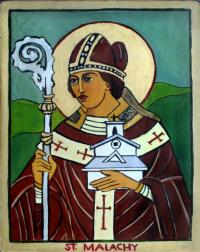
St. Malachy (c.1095 – 1148)
Feast day: 3 November
Malachy was born in Armagh in 1095 and was a member of the clan Ua Morgair. He was educated by Imhar O’Hagan (future abbot of Armagh) and was ordained a priest in 1119 by St Ceallach. After his ordination Malachy was appointed vicar at Armagh and ministered in the absence of Ceallach who was engaged in the administration of the diocese of Dublin. After two years Malachy travelled to Lismore for further study under Malchus who was recently retired from the archdiocese of Cashel. The monastery in Lismore had strong affiliations with Great Britain and Europe. As a result Lismore was exposed to the reforms which were commenced by Pope Gregory VII in the Church towards the end of the 11th century.
In 1124 Malachy was appointed bishop of Down and Connor. On receiving this appointment he set about restoring the monastery at Bangor in Co. Down. Furthermore Malachy began working on reform within his diocese. Unfortunately this led to vehement disputes and he was compelled to leave. From there Malachy travelled with his monks to Iveragh in Co. Kerry.
Ceallach died in 1129, however on his death-bed he expressed his wish that Malachy would succeed him as primate. In expressing this wish Ceallach would undo an Irish tradition of hereditary succession. The clan to which Ceallach belonged was known as clan Sínaigh and this clan had held on to the office of primate in Armagh for over 200 years in hereditary succession. The holding of the office of a prelate in this manner was one of a number of abuses within the Irish Church for many decades. Ceallach’s seeking of Malachy was one where an outsider of the clan was sought to undertake the primacy. This brought to an end the monopoly of the clan Sínaigh, and it was also a call to end such monopolies within the Church. Malachy was appointed as Archbishop of Armagh in 1132, an office that he was very reluctant to undertake but was persuaded to do so by the papal legate and the bishop of Lismore. A counter-appointment was made from the clan Sínaigh when Muircheartach was appointed who was favoured by purists. Muircheartach was due to succeed Ceallach on his death. When Muircheartach died in 1134 Malachy returned to Armagh and took up his appointment, where he remained for three years. In 1137 Malachy resigned at Armagh and returned to Bangor, where he separated Down and Connor into two separate dioceses. He held on to the diocese of Down and another bishop was appointed for Connor.
Malachy decided to travel to Rome and set off 1139 and visited St Bernard of Clairvaux en route. When in Rome he asked the Pope to confer the pallium on the sees of Armagh and Cashel. Malachy’s vision for hierarchical primacy was to establish archbishoprics at Armagh and Cashel and the pallia would be the seal of approval for these sees. The pope of the time was Innocent II, who appointed Malachy as legate for Ireland but did not confer the pallia. On his return journey to Ireland he again visited the renowned abbot St Bernard at Clairvaux. Malachy obtained a number of monks to travel with him to establish a monastery in Ireland. Subsequently the monastery of Mellifont was founded in 1142 near Drogheda in Co. Louth. He also visited the Augustinian priory at Arrouaise in Flanders during his visit to the continent and brought the order to Louth in 1142. On his return to Ireland Malachy also travelled throughout Ireland for six years. He used his office of papal legate to pursue a programme of Church reform. He revised many church laws and revitalised Church life in Ireland as well as holding numerous synods nationwide.
Malachy travelled to Rome again in 1148 to attempt a second petition for the pallium to be conferred to Ireland. A Cistercian from Clairvaux had been appointed Pope and Malachy discerned that there may be opportunity to petition for the pallia again. His journey was plagued with diplomatic difficulties and Malachy travelled to Clairvaux. Unfortunately Malachy would never return to Ireland. He fell ill of fever and died in the company of Bernard and his monks in November 1148 in Clairvaux Abbey. Malachy’s body was interred at Clairvaux Abbey after his death. During the French Revolution in the 18th century the tombs of Ss. Malachy and Bernard were opened and their relics dispersed. However it was negotiated that some of Malachy’s relics be transferred to Armagh in 1982 and were interred within the new altar during the re-dedication of Armagh cathedral.
St Bernard of Clairvaux has been noted as being the primary source of Malachy’s life from his biography and numerous correspondences between them. The monks of Clairvaux requested for his canonisation which was approved in 1190 by Pope Clement III. Malachy was canonised in 1962 by St John XXIII.
